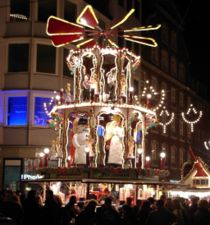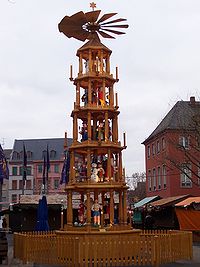- Christmas pyramid
-
 An example at the Christmas Market in Düsseldorf
An example at the Christmas Market in Düsseldorf A pyramid at the Christmas market in Mainz
A pyramid at the Christmas market in Mainz
A Christmas Pyramid (German: Weihnachtspyramide) is a Christmas decoration that has its roots in the Erzgebirge (Ore Mountains) of Germany but has become popular throughout the country. It is suggested that the Christmas pyramid is a predecessor of the Christmas tree;[1] These pyramids themselves are not limited to Christmas: in the Erzgebirge existed a custom of dancing around the "St. John's Tree," "a pyramid decked with garlands and flowers," at the summer solstice.[2]
It is a kind of Carousel with several levels some depicting Christian motifs, such as angels or manger scenes, and others with more secular motifs such as mountain-folk, forests, and other scenes from the everyday life of people in the Erzgebirge. The spinning motion of the pyramids is traditionally achieved with the help of candles whose rising heat spins a propeller above.
Christmas pyramids serve a mainly decorative purpose today, filling children and adults alike with holiday cheer.
Generally Christmas pyramids are made of wood and based on four- to eight-sided platforms with a long pole in the middle serving as the axle to which the entire apparatus tapers above and which supports any further platforms. Inside in a glass or ceramic support is a driveshaft on to which at least one platform is attached. The figures, which stand on the platforms are also traditionally made of wood.
Christmas pyramids take various forms from intricately carved miniature houses with pitched roofs, to large multi-level structures that simply serve as a display for the carved figures. In many cities in the Ore Mountains there are large Christmas pyramids on the Market Square at the Christmas Market or in other locations associated with Christmas hustle and bustle.
History of the Christmas pyramid
The origins of the Christmas pyramids date back to the Middle Ages. In this period it was traditional in southern and western Europe to bring evergreen branches, for example boxwood into the home and hang them, in order to ward off moroseness in the dark and cold winter months. In northern and eastern Europe traditional candles were used to achieve this goal. The Christmas pyramid would eventually unify these two traditions and become a symbol of Christmas celebrations. The forefather to the pyramid was a construction known as a "Lichtergestelle" (literally: thing on which lights are set) and were very popular in the 18th century. They were constructions made of four poles, decorated with evergreen boughs, tied together at the top and lit with candles. In the large cities, the Christmas tree, now recognizable all over the world, gradually replaced the Lichtergestelle, but in the mountains, the people did not see a simple tree bedeckt with lights, rather they were reminded of the capstans, which were commonly used in the mines of the Ore Mountains. To the pyramid shape was added the spinning motion of the capstan and the earliest Christmas pyramids were born.
The name "Christmas pyramid" came about because the Napoleonic Campaign in Egypt at the end of the 18th Century brought pictures of the pyramids back to Europe and eventually to the Ore Mountains, where they reminded the people of the mining capstans and also of the Christmas constructions.
An important breakthrough in the popularity of the Christmas pyramid came around 1830 with the discovery of kerosene. Previously, people had used relatively expensive candles or rapeseed oil. As the means to light and spin the pyramids became much cheaper, the tradition spread. Now such pyramids can be found in numerous styles and sizes all over Germany as well as in many parts of the United States.
See also
- Wooden toymaking in the Ore Mountains
References
- ^ Forbes, Bruce David (2007). Christmas: A Candid History. U of California P. p. 49. ISBN 9780520251045. http://books.google.com/books?id=ap8unt4cP54C&client=firefox-a.
- ^ Miles, Clement A. (1976). Christmas Customs and Traditions: Their History and Significance. Courier Dover. p. 269. ISBN 9780486233543.
- This article incorporates information from the revision as of November 21, 2006 of the equivalent article on the German Wikipedia.
Categories:- Christmas in Germany
- Christmas traditions
- Christmas decorations
Wikimedia Foundation. 2010.


